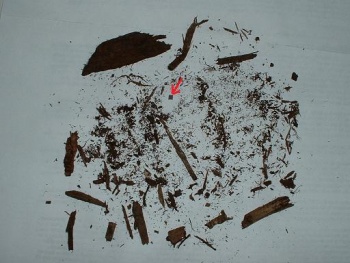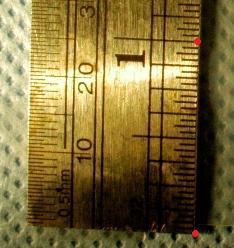This site is devoted to mathematics and its applications. Created and run by Peter Saveliev.
Category:Calibration
From Intelligent Perception
Calibration is finding the number of inches/meters/microns per pixel, or vice versa. For example:
1 mm = 13 pixels.
Here 13 is the calibration factor.
The way to figure out the actual sizes of the objects (in, say, millimeters) in the image is to have something in the image the actual size of which is known. The process is called "calibration" and below is a list of a few examples of how it's done with Pixcavator. If there isn't anything identifiable in your images, consider if it's possible to insert something like that in the image before it is taken or take a picture of that object separately but under the exact same circumstances. If it is not, the only way that's left is to know the size of the image itself or, more precisely, the size of the captured area. (Consider also stereo vision.)
The easiest way to find the calibration factor is to take a picture of a ruler and then find the distance between its ends - in pixels (you may have to use the Euclidean distance formula). Say 150 pixels. The ruler tells you the distance in mm (inches etc). Say 50 mm. Now you can compare the two numbers and compute the calibration factor: 1 mm = 30 pixels.
However, you can use that number with other pictures but only if you take them all at exactly same distance, depending on how much accuracy you need.
Another way to find this number is to know the area of an object in the image.
You can also use the perimeter instead of area. One thing to keep in mind though is that the accuracy of computation of lengths is limited (see lengths of curves) regardless of the image resolution.

Learn how to use Pixcavator!
Below you'll find a few examples of image analysis with Pixcavator.
Pages in category "Calibration"
The following 13 pages are in this category, out of 13 total.
CM |
M cont. |
PST |
Digital discoveries
- Casinos Not On Gamstop
- Non Gamstop Casinos
- Casino Not On Gamstop
- Casino Not On Gamstop
- Non Gamstop Casinos UK
- Casino Sites Not On Gamstop
- Siti Non Aams
- Casino Online Non Aams
- Non Gamstop Casinos UK
- UK Casino Not On Gamstop
- Non Gamstop Casino UK
- UK Casinos Not On Gamstop
- UK Casino Not On Gamstop
- Non Gamstop Casino UK
- Non Gamstop Casinos
- Non Gamstop Casino Sites UK
- Best Non Gamstop Casinos
- Casino Sites Not On Gamstop
- Casino En Ligne Fiable
- UK Online Casinos Not On Gamstop
- Online Betting Sites UK
- Meilleur Site Casino En Ligne
- Migliori Casino Non Aams
- Best Non Gamstop Casino
- Crypto Casinos
- Casino En Ligne Belgique Liste
- Meilleur Site Casino En Ligne Belgique
- Bookmaker Non Aams
- онлайн казино с хорошей отдачей
- スマホ カジノ 稼ぐ
- Trang Web Cá độ Bóng đá Của Việt Nam

